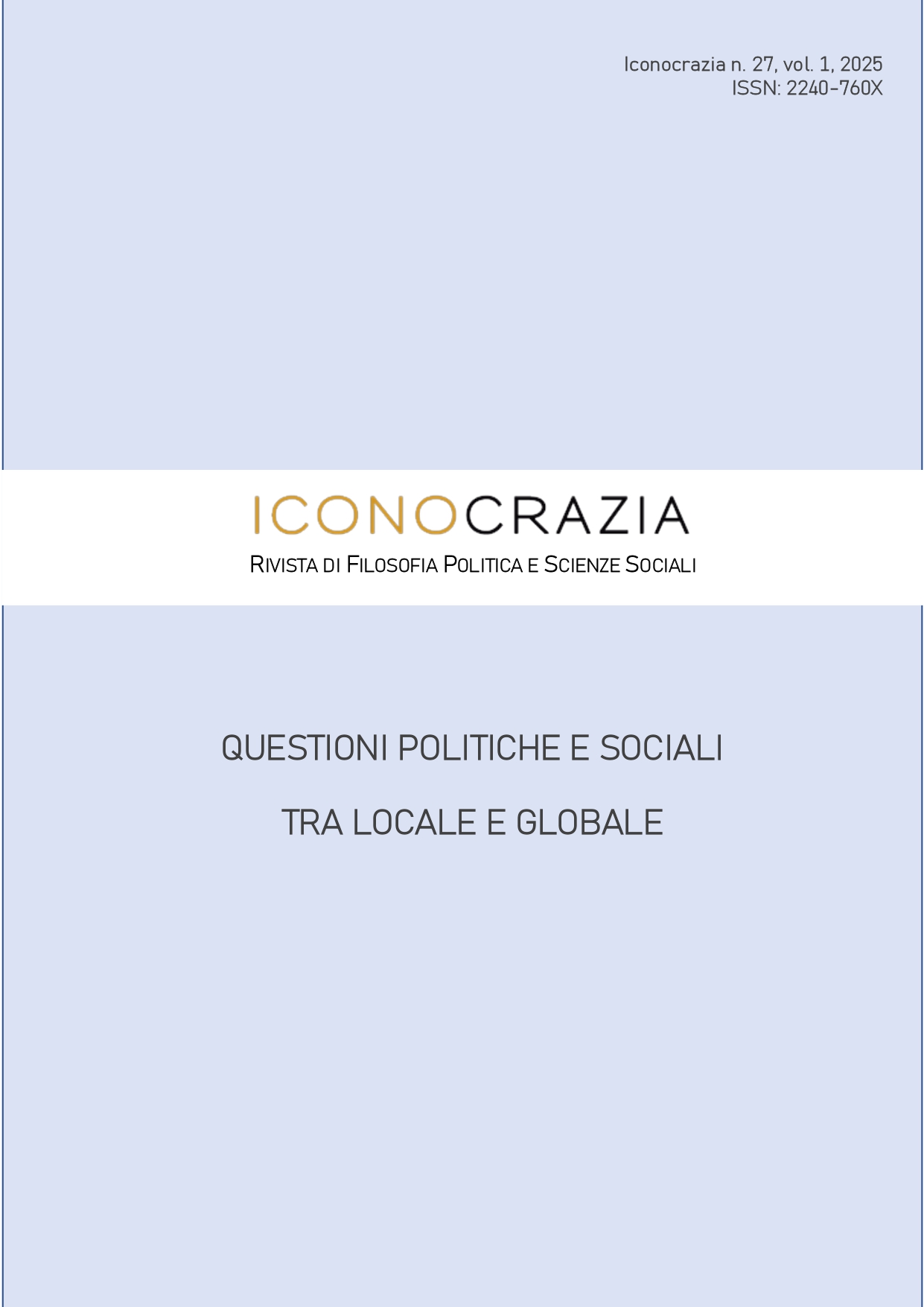Queer safer spaces. Una mappatura di comunità tra spazi, pratiche e soggettività a Lecce per una rete del desiderio e della cura
DOI:
https://doi.org/10.15162/2240-760X/2323Parole chiave:
Queer, spazi, safe, comunità, pratiche, spaces, safer spaces, community, practicesAbstract
Scopo della ricerca è ricostruire la rete di spazi, pratiche e soggettività offline e online della comunità queer della città di Lecce, impegnata in percorsi partecipativi di lotta per visibilità e diritti. La comunità queer si esprime attraverso una serie di pratiche di queerizzazione degli spazi che mescolano il privato con il pubblico, l'attivismo con la performance e la produzione culturale. La definizione di spazi-eventi e spazi safer di comunità produce contro-pubblici della cura. La metodologia proposta è di stampo qualitativo, includendo forme di etnografia tra offline e online, osservazione partecipante e interviste a testimoni privilegiati.
This study seeks to reconstruct the network of spaces, practices, and subjectivities—both offline and online—constituting the queer community in the city of Lecce, which is engaged in participatory struggles for visibility and rights. The community articulates itself through practices of spatial queering that blur the boundaries between private and public spheres, activism and performance, as well as cultural production. The constitution of event-spaces and safer community spaces fosters the emergence of counter-publics of care. Methodologically, the research adopts a qualitative approach, combining online and offline ethnography, participant observation, and in-depth interviews with key informants.
Riferimenti bibliografici
Ammaturo, F. R. (2019). ‘The more South you go, the more frankly you can speak’: Metronormativity, critical regionality and the LGBT movement in Salento, South-Eastern Italy. Current Sociology, 67(1), 79-99.
Ayoub, P. M., Brzezinska, (2015), Caught in a Web?: The Internet and the Deterritorialization of LGBT Activism, The Ashgate Research Companion to Lesbian and Gay Activism
Blanco, V., (2023), Ghiaccio e insulti contro la drag queen sul palco. La denuncia: “Umiliata dai calciatori”. Poi le scuse, Quotidiano di Puglia, consultabile su: https://www.quotidianodipuglia.it/lecce/martano_insulti_contro_drag_queen_palco_denuncia_umiliazione_calciatori-7800320.html
Bonu, G. (2019), Mappe del desiderio. Spazi safe e pratiche transfemministe di riappropriazione dell’urbano, in Belingardi, C., Castelli, F., Olcuire, S., a cura di, La libertà è una passeggiata. Donne e spazi urbani tra violenza
strutturale e autodeterminazione, Iaph Italia, pp. 73-84
Bonu, G. (2022). Diving into the tide. Contemporary feminist mobilizations and protests: A global perspective. AG About Gender-International Journal of Gender Studies, 11(21).
Bonu Rosenkranz, G., Castelli, F., Olcuire, S., Bruci la città. Generi, transfemminismi e spazio urbano, Edifir
Banfi, G., & Bonazzi, M. (2024). A Study in Pink: Le narrazioni digitali dell'influattivismo femminista. Mediascapes journal, 24(2), 58-73.
Boccia Artieri, G. (2021). Networked participation: selfie protest and ephemeral public spheres. The Aesthetics and Politics of the Online Self: A Savage Journey into the Heart of Digital Cultures, 331-356.
Boccia Artieri, G., Zurovac, E., & Donato, V. (2022). Visibility and networked. Participation in TikTok. The Breonna Taylor Trend. Comunicazione politica, 23(3), 403-422.
Bradford, N. J., & Syed, M. (2019). Transnormativity and transgender identity development: A master narrative approach. Sex Roles, 81(5), 306-325.
Burn, S. M. (2000). Heterosexuals' use of “fag” and “queer” to deride one another: A contributor to heterosexism and stigma. Journal of Homosexuality, 40(2), 1-11.
Calefato, P. (2021). La moda e il corpo. Teorie, concetti, prospettive critiche (pp. 1-222). Carocci.
Calefato, P., Forte, G., 2024, Fashion Performances in a drag scene, Russian Fashion Theory, 74, pp. 343-364
Castelli, F., (2023), Spazio, corpi, politica, in Bonu Rosenkranz, G., Castelli, F., Olcuire, S., Bruci la città. Generi, ttransfemminismi e spazio urbano, Edifir, pp. 25-27
Chisholm, D. (2005). Queer Constellations: Subcultural Space in the Wake of the City (NED-New edition). University of Minnesota Press. http://www.jstor.org/stable/10.5749/j.ctttsdct
Colonna, I. (2021). Attivismo tra reti digitali e incontri di sguardi. Il caso del Movimento No Tap. H-ermes: Journal of Communication, (20).
Cremonesini, V., 2011, Città e potere. Per un’analisi foucaultiana dello spazio urbano, Besa
Cremonesini, V., Cristante, S., & Longo, M. (2014). Smallville e il salotto invisibile. La percezione del potere in una piccola città: un'introduzione. In Il salotto invisibile. Chi ha il potere a Lecce? (pp. 9-64). Besa Salento Books.
de Winkel, T. (2023). Fringe platforms: An analysis of contesting alternatives to the mainstream social media platforms in a platformized public sphere (Doctoral dissertation, Utrecht University).
Duguay, S. (2022). Personal but not private: Queer women, sexuality, and identity modulation on digital platforms. Oxford University Press.
Ekenhorst, M. & van Aalst, I. (2019) Lesbian nightlife in Amsterdam: an explorative study of the shift from ‘queer-only’ to ‘queer-friendly’ spaces.
Fennia 197(2) 200–214. https://doi.org/10.11143/fennia.83696
Fagiani, M. L. (2018). City of orgies, walks and joys: la produzione dello spazio e del tempo nella città queer. Fuori Luogo. Rivista di Sociologia del Territorio, Turismo, Tecnologia, 4(2), 41-54.
Forte, G. (2020). Ma con la B posso dirla?”: social media e percorsi di negoziazione della n-word tra appropriazione culturale e policy della piattaforma. Echo, (2), 176-184.
Forte, G. (2024). Corpi sonori queer: Soggettività e comunità transfemministe nello spazio performativo safe del dj set. Connessioni Remote. Artivismo_Teatro_Tecnologia, (8). https://doi.org/10.54103/connessioni/26589
Galpin, C., Gwenffrewi, G., & Stokoe, A. (2023). Transfeminist perspectives: Beyond cisnormative understandings of the digital public sphere. European Journal of Women’s Studies, 30(4), 502-515.
Gieseking, J. J. (2020). Mapping lesbian and queer lines of desire: Constellations of queer urban space. Environment and Planning D: Society and Space, 38(5), 941-960.
Guhl, J., & Davey, J. (2020). A safe space to hate: White supremacist mobilisation on Telegram. Institute for Strategic Dialogue, 26.
Hammack, P. L., Frost, D. M., & Hughes, S. D. (2019). Queer intimacies: A new paradigm for the study of relationship diversity. The Journal of Sex Research, 56(4-5), 556-592.
Hartal, G. (2018). Fragile subjectivities: constructing queer safe spaces. Social & Cultural Geography, 19(8), 1053–1072.
https://doi.org/10.1080/14649365.2017.1335877
Hine, C., 2015, Ethnography for the Internet Embedded, Embodied and Everyday, Routledge
Hooks, B. (2014). Sisterhood: Political solidarity between women. In Feminist Social Thought (pp. 484-500). Routledge.
Kern, L. (2021). Feminist city: Claiming space in a man-made world. Verso Books.
Jane, E. A. (2016). Online misogyny and feminist digilantism. Continuum, 30(3), 284–297. https://doi.org/10.1080/10304312.2016.1166560
Jackson Levin, N., Kattari, S. K., Piellusch, E. K., & Watson, E. (2020). “We just take care of each other”: navigating ‘chosen family’in the context of health, illness, and the mutual provision of care amongst queer and transgender young adults. International journal of environmental research and public health, 17(19), 7346.
Johnston, L. (2007). Queering tourism: Paradoxical performances of gay pride parades. Routledge.
Johnson, A. H. (2016). Transnormativity: A new concept and its validation through documentary film about transgender men. Sociological inquiry, 86(4), 465-491.
Lagarde, M. (2016). Los cautiverios de las mujeres: madresposas, monjas, putas, presas y locas. Siglo XXI Editores México.
Lohman, K. (2024). Creating a safer space: Being safe and doing safety in queer and feminist punk scenes. The Sociological Review, 72(5), 1156-1173.
Marcus, G. E., (1995), Ethnography in/of the World System: The Emergence of Multi-Sited Ethnography, Annual Review of Anthropology, Vol. 24, pp. 95-117
Marocco, A. (2023). Abitare con cura: geografie queer e diritto alla città delle comunità urbane LGBTQ+. Il progetto Co-housing Queerinale/Agapanto (Roma). Scienze del Territorio, 11(1), 88-99.
McCartan, A., & Nash, C. J. (2023). Creating queer safe space: relational spacemaking at a grassroots LGBT pride event in Scotland. Gender, Place & Culture, 30(6), 770–790. https://doi.org/10.1080/0966369X.2022.2052019
McGlashan, H., & Fitzpatrick, K. (2018). ‘I use any pronouns, and I’m questioning everything else’: transgender youth and the issue of gender pronouns. Sex Education, 18(3), 239-252.
Millett, K. (2016). Sexual politics. Columbia University Press.
Neary, A., Gray, B., & O'Sullivan, M. (2016). A queer politics of emotion: Reimagining sexualities and schooling. Gender and education, 28(2), 250-265.
Olcuire, S. (2019). Città a misura di donne o donne a misura di città? La mappatura come strumento di governo e sovversione del rapporto tra sicurezza e genere. In La libertà è una passeggiata. Donne e spazi urbani tra violenza strutturale e autodeterminazione (pp. 85-99). IAPh Italia.
Pain, P. (Ed.). (2023). Global LGBTQ Activism: Social Media, Digital Technologies, and Protest Mechanisms. Taylor & Francis.
Passa, D. (2021). "You all are sisters! We are all family!" The construction of parenthood in RuPaul's Drag Race. Linguaculture, 12(2), 127-144.
Piras, G., & Mazzaglia, S. (2023). A chi appartiene la città? Strumenti di riappropriazione dello spazio pubblico in una città disegnata (ancora) da uomini. Il caso studio di CHEAP a Bologna. IN_BO. Ricerche e progetti per il territorio, la città e l'architettura, 14(18), 118-129.
Pisanello, C., (2017), In nome del decoro. Dispositivi estetici e politiche securitarie, Ombre Corte
Puricella, A., (2023), ‘Queer è ora’: la fotografia contro i pregiudizi di genere al castello di Corigliano d’Otranto, La Repubblica, consultabile su: https://bari.repubblica.it/cronaca/2023/07/21/news/queer_e_ora_la_fotografia_contro_i_pregiudizi_di_genere_al_castello_di_corigliano_dotranto-408504397/
Ramos, R., Mowlabocus, S., (2021), Queer Sites in Global Contexts: Technologies, Spaces, and Otherness, Routledge
Rand, E. J. (2012). Gay pride and its queer discontents: ACT UP and the political deployment of affect. Quarterly Journal of Speech, 98(1), 75-80.
Rinaldi, C., 2022, Media digitali e sessualità non normative, in Farci, M., Scarcelli, M., Media digitali, genere e sessualità, a cura di, Mondadori, pp. 144-155
Sassen, S., (2018), Espulsioni. Brutalità e complessità nell'economia globale, Il Mulino
Schwartz, B., & Neff, G. (2019). The gendered affordances of Craigslist “new-intown girls wanted” ads. New Media & Society, 21(11-12), 2404-2421. https://doi.org/10.1177/1461444819849897
Schopper, T., Berbers, A., & Vogelgsang, L. (2024). Pride or Rainbow-Washing? Exploring LGBTQ+ Advertising from the Vested Stakeholder Perspective. Journal of Advertising, 1-18.
Semenzin, S., & Bainotti, L. (2020). The use of Telegram for non-consensual dissemination of intimate images: Gendered affordances and the construction of masculinities. Social Media+ Society, 6(4), 2056305120984453.
Siebler, K. (2018). Learning Queer Identity in the Digital Age, Palgrave Macmillan, Taylor, J. (2012). Scenes and sexualities: Queerly reframing the music scenes perspective. Continuum, 26(1), 143–156. https://doi.org/10.1080/10304312.2011.538471
Warner, M. (2002), Publics and counterpublics (abbreviated version). Quarterly Journal of Speech, 88(4), 413–425. https://doi.org/10.1080/00335630209384388
Worthen, M. G. (2023). Queer identities in the 21st century: Reclamation and stigma. Current Opinion in Psychology, 49, 101512.
Vivienne, S., & Burgess, J. (2012). The digital storyteller's stage: Queer everyday activists negotiating privacy and publicness. Journal of Broadcasting & Electronic Media, 56(3), 362-377.
Zardi, A. (2023). La ritualità del clubbing: la riappropriazione queer della notte, in TWM Factory, a cura di, Queer Pandèmia. Contaminazioni artistiche di altro genere, Tlon, pp. 103-110
Zimman, L. (2017). Transgender language reform: Some challenges and strategies for promoting trans-affirming, gender-inclusive language. Journal of Language and Discrimination, 1(1), 84-105.
Zottola, A. (2024). LGBTQ+ and Feminist Digital Activism: A Linguistic Perspective. Elements in Language, Gender and Sexuality.Perspectives on Student Political Activism. Comparative Education. 25(1):97-100.







